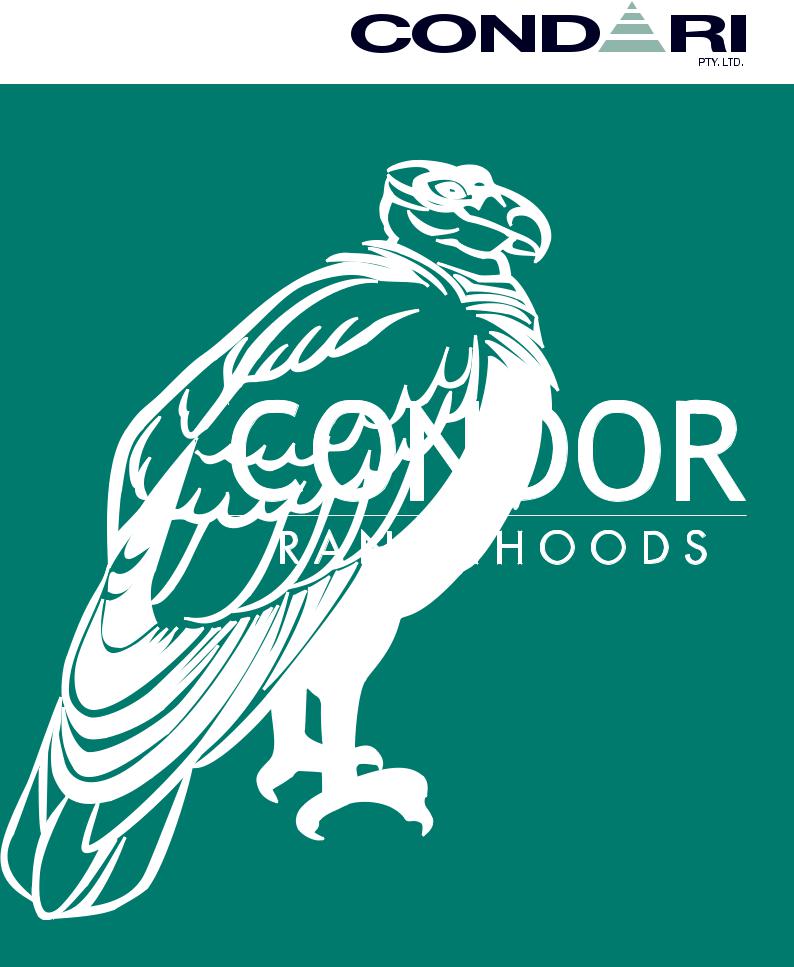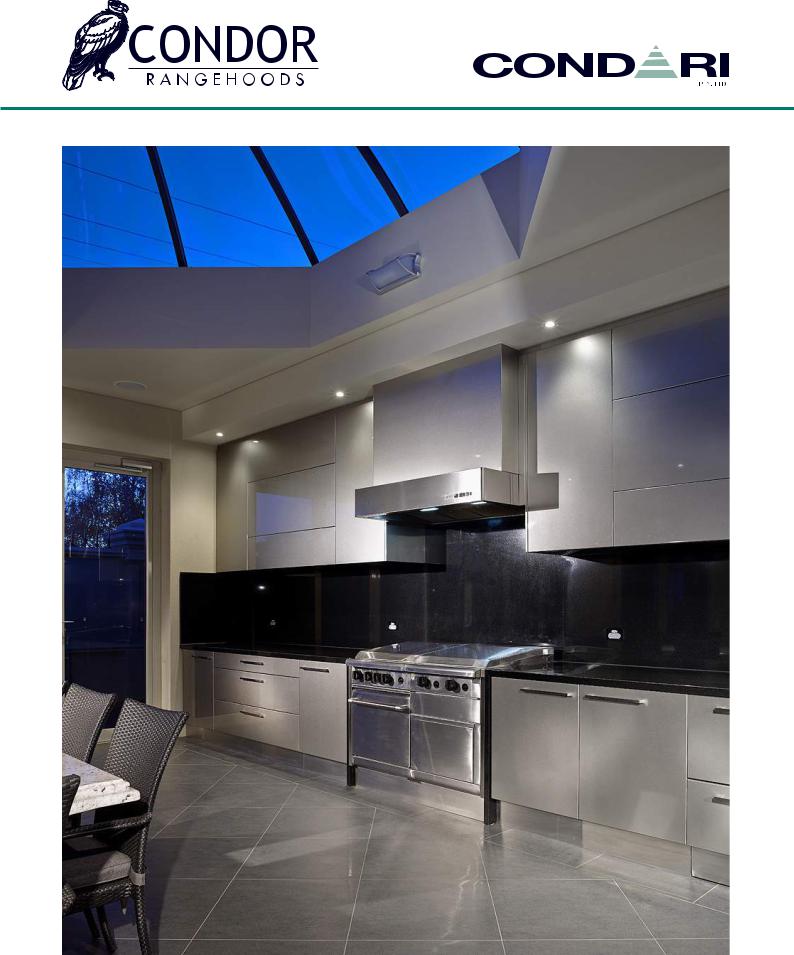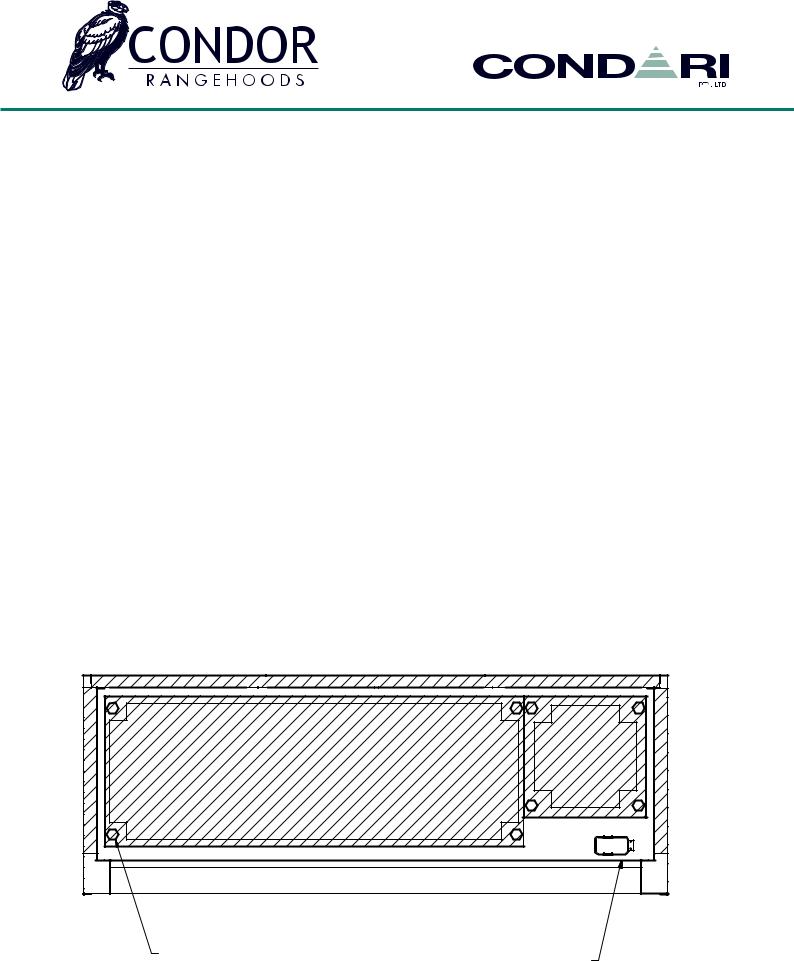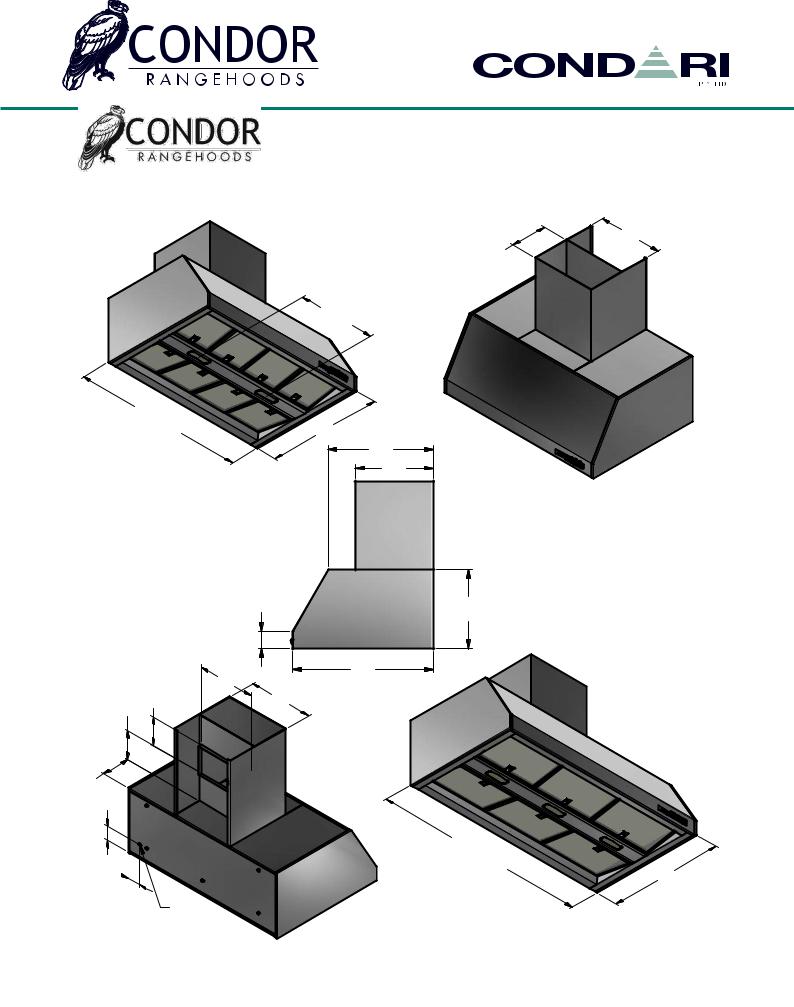Qasair BAL1000L3, BCM10003SS, BCM1000L3, BAL1200L3, BCM1200L3 Installation Guide
...

Boston Rangehood
|
|
2 |
Condor Rangehood Installation Instructions |

Important Information |
4 |
|
|
|
|
Instructions for Models |
6 |
|
BSF / BCM / C / BAL |
||
|
||
|
|
|
Instructions for Models |
12 |
|
DAR / FAL / ICU / CUB |
||
|
||
|
|
|
Ducting Pieces |
18 |
|
|
|
|
Cleaning |
20 |
|
|
|
|
Guarantee & Exclusions |
21 |
|
|
|
|
Warranty |
23 |
|
|
|
|
|
Condor Rangehood Installation Instructions |
3 |

IMPORTANT INFORMATION
CONDARI PTY LTD makes over 120 different models of QASAIR and CONDOR Rangehoods plus many specials designed by architects and interior designers.
It is important to follow the installation instructions for different models.
The following is general advice for the installation of CONDOR Rangehoods and is meant as a guide.
Firstly, there are many different cooking appliances on the market today and we list some here.
Electric Eco, Ceramic hotplates, Teppanyaki plates and Induction hotplates, which need special cooking equipment. There are gas hotplates with four burners and a wok burner or fish burner of all different heat output.
Many companies offer a vario system with individual two gas burners, a wok burner, electric ceramic hotplate, an electric griller or barbecue and an induction hotplate. There are three gas cooking appliances with an open flame griller or barbecue.
Gas regulations require different heights for different brands of hoods. CONDOR hoods can be fitted between
1000 mm to 1400 mm above the barbecue. This is due to the fact they do not have plastic motors.
1.The installation of CONDOR Rangehoods must comply with the information in this booklet. CONDOR
Rangehoods are designed and made to work efficiently over all domestic cookware available on the
Australian market.
2.Every CONDOR Rangehood must be ducted to the outside atmosphere by the use of zinc-alume duct or non-porous and non-flammable materials. We do not recommend the use of any type of flexible ducting or plastic PVC piping (barbecue heat output will affect flexible ducting and cause it to desintegrate). Rangehoods must not be vented into a wall cavity or a ceiling space. This prevents a build up of grease, which can be a fire risk. Ensure the external outlet vent does not restrict the airflow in any way, as this may result in reduced performance.
3.CONDOR Rangehoods must be ducted in duct work equivalent to the outlet of the rangehood
ie: The cross sectional area of the rangehood outlet and the duct work must be equal. Do not reduce the duct size or have sharp bends. Enlarge the duct size if the duct is to run 6 metres or longer. Advice from
CONDOR is available to ensure optimum performance. Always use nonflammable materials to minimise the risk of fire in the duct at a later date.
4.Ensure all ducting pieces are correctly fitted and sealed with either duct tape or silicone to ensure that fumes do not escape into the ceiling space and seep into living areas through vents or light fittings. The installation and fitting of the rangehood should be done in such a way that will allow the unit to be removed if service is required. Additional costs incurred in the removal of wall tiles, damage to walls or bench tops are not covered by warranty.
5.Always adequately ventilate the room when the rangehood is in use at the same time as appliances burning gas or other fuels.
6.WARNING: Incorrect venting will result in additional noise and a reduction in efficiency. Exhaust air must not
|
|
4 |
Condor Rangehood Installation Instructions |

be discharged into any chimney or flue, which may carry combustible products from other sources.
a)Do not discharge the air-flow from the rangehood into a flue used for exhausting fumes from burning gas or fuel;
b)A reduction in ducting size will result in the motors eventually failing and will need replacement.
c)For cleaning purposes please refer to page 20 of installation instructions for stainless steel;
d)If cleaning is not carried out in accordance with the instructions as listed on page 20, you
may have an increased risk of fire;
e)Accessible parts of the rangehood may become hot when used with cooking appliances;
f)This appliance is not intended for use by persons (including children) with reduced physical, sensory or mental capabilities, or lack of experience and knowledge, unless they have been given supervision or instruction concerning use of the appliance by a person responsible for their safety.
7.If the supply cord is damaged, an authorised service centre or licensed electrician must replace it.
8.NOTE: CONDOR recommend minimum air movement of 2000 cubic metres per hour and recomment up to 2700 cubic metres per hour over a barbecue, depending on the length of the duct run. Barbecues should be positioned under the centre of the hood where the fans are mounted and not near the outer edges where leakage may occur. Please also note barbecue lid position, as if it does not open to a 90 degree angle the smoke and by-products can be diverted forward and away from the rangehood catchemt area.
9.The lights in the rangehoods are LED.
10.To reduce the risk of fixing screws coming in contact with live parts, do not drill or screw into the rangehood.
Live wires are encapsulated where possible to prevent user contact. If necessary drill from the inside out and only through single sheet material.
11.CONDARI PTY LTD can manufacture rangehoods to be used over commercial cookers in domestic applications.
NOTE: Installation must comply with local State & Council regulations.
|
|
Condor Rangehood Installation Instructions |
5 |

INSTALLATION INSTRUCTIONS CONDOR RANGE
To suit wall mounted models:
•Balmoral
•Boston
•Cubica
•Baltimore
1.Determine hood position on wall 1000mm to 1400mm above barbecue.
2.Unpack Rangehood.
3.Mark centre line on wall.
4.Mark base line on wall (Note: if shroud being used, the height of the shroud will determine the height of the hood).
5.Mark the outlet hole in the ceiling for the flue and cut out, removing any obstructions allowing clear access for the flue (Note: if using rear duct, mark and cut hole at this time).
6.Remove the perforated rear panel in hood by removing bolts with a 7mm hex socket.
7.Drill fixing holes in rear of hood to suit available fixing points on wall making sure to get fixing as high and as wide as possible in Rangehood to avoid sagging from wall. (Please refer to Rangehood diagram for example of possible fixing points)
8.Remove plastic cover from rear mounting plate and fix to wall at base height of hood making sure this is level and exactly central.
9.Transfer fixing locations from hood to wall and drill fixing holes. Insert plugs to allow or use
Dyna bolts as an alternative.
10.Locate position for power cable and drill hole for cable using a hole saw. Consult your electrician for his preferred location.
Perforated |
panels |
7mm hex bolt head |
Electrical |
|
|
|
junction box |
|
|
6 |
Condor Rangehood Installation Instructions |

11.Fit stainless flue to top of hood with 4 supplied fixing screws while hood is on ground to avoid having to drop stainless flue down through hole in the ceiling and causing possible damage to the flue. (If using shroud it can be fitted either at this stage or carefully after hood is on wall)
12.Remove fans if needed and lift hood up onto mounting bracket carefully guiding flue through hole in ceiling and bringing power cable into hood during this process. You will require up to 3 people for this lifting stage as hood is quite awkward and heavy to lift.
13.Screw or bolt hood to wall securely making sure hood is level and sitting properly on mounting bracket. It is advisable to have portable stands ready for this stage as hood will get quite heavy.
14.Refit perforated panel in the rear or the hood and refit fans if they have been removed.
15.Make electrical connection to junction box inside bottom right side of hood.
16.Extend ducting through roof to exterior and fit roof cowl making sure to seal roof penetration with preferred flashing material. (Note: there are several on the market to suit the type of roof you have, so consult your plumber for the best product to suit)
|
|
Condor Rangehood Installation Instructions |
7 |

BALMORAL (BSF)
Top Ducted |
|
|
|
|
Top Ducted |
|
|
|
|
|
|
||
|
|
|
|
|
4 |
|
|
|
|
|
|
5 |
|
|
|
|
|
|
|
0 |
|
|
|
|
|
0 |
|
|
|
|
|
|
5 |
|
|
|
|
|
|
2 |
|
|
|
L |
|
|
|
|
C |
|
|
i |
|
|
|
|
|
g |
|
|
||
e |
|
|
h |
|
||
|
n |
|
|
t |
|
|
|
|
t |
|
|
|
|
|
|
|
r |
|
|
|
|
|
|
e |
|
|
|
|
|
|
s |
|
||
BodyW idth
Back Ducted
m |
4 |
|
0 |
||
XMnmuii25m.m |
020 |
0 |
|
||
|
0 |
|
0 |
|
8 |
|
600 |
|
445 |
|
005 |
001 |
054 |
|
800 |
4 |
|
5 |
|
|
0 |
Top Ducted
5 9 1
00 1
93

Power
Entry.
The flues available for BSF rangehoods are
The flues available for BSF rangehoods model No DL-BC BSF and come in lengths of are model No DL-BC and come in lengths 600,of 6900, 900,or 1200mm200mmor . .
B |
|
o |
|
d |
|
y |
|
Wi |
|
d |
|
t |
|
h |
0 |
|
0 |
|
8 |
LED Lights
Electrical connection is to be at the junction box inside the rangehood. All BSF rangehoods have 3 fans to ensure all smoke from the barbecue is removed from the alfresco area.
|
|
8 |
Condor Rangehood Installation Instructions |
